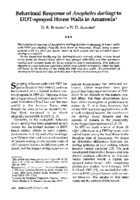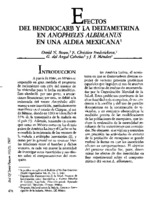Effects of Permethrin-impregnated bed nets on malaria vectors of northern Guatemala
| dc.contributor.author | Richards, Frank O | es_ES |
| dc.contributor.author | Zea Flores, Rodolfo | es_ES |
| dc.contributor.author | Sexton, John D | es_ES |
| dc.contributor.author | Beach, Raymond F | es_ES |
| dc.contributor.author | Mount, Dwight L | es_ES |
| dc.contributor.author | Cordón Rosales, Celia | es_ES |
| dc.contributor.author | Gatica, Mario | es_ES |
| dc.contributor.author | Klein, Robert E | es_ES |
| dc.date.accessioned | 2016 | |
| dc.date.available | 2016 | |
| dc.date.issued | 1994 | es_ES |
| dc.identifier.uri | https://iris.paho.org/handle/10665.2/26944 | |
| dc.description.abstract | 8The authors evaluated the effects on malaria vectors of bed nets impregnated with permethrin over the course of a 16-month controlled study in four communities of Northern Guatemala. Anopheles albimanus and An. vestitipennis were the known malaria vectors in the area. Households were allocated to one of three experimental groups: those receiving bed nets impregnated with 500 mg/m2 of permethrim, those receiving untreated bed nets, and those where no intervention measures were taken. The impact of the treated and untreated bed nets on mosquito abundance, behavior, and mortality was determined by indoor/outdoor night-bite mosquito collections, morning pyrethrum spray collections, inspection of bed net surfaces for dead mosquitoes, and capture-release-recapture studies. The duration of the treated nets' residual insecticide effect was assessed by modified WHO cone fiel bioassays, and their pyrethrin content was estimated by gas-liquid chromatography analysis. The most important observation was that fewer mosquitoes were found to be resting in the households with treated bed nets. The treated nets probably functioned by both repelling and killing vector mosquitoes. Capture-release-recapture studies showed exit rated from houses with treated nets were higher (94 percent) than those from control houses (72 percent), a finding that suggests repellency. However, no significant differences were noted between the indoor night-bite mosquito collections at houses with and without treated nets. The horizontal surfaces of treated bed nets were nearly 20 times more likely to contain dead anopheline mosquitoes than were the comparable surfaces of untreated nets. The bioassays indicated that unwashed permethrin-impregnated bed nets retained their insecticidal activity for 6 months after treatment | en_US |
| dc.description.abstract | This article will also be published in Spanish in the BOSP. Vol. 117, 1994 | en_US |
| dc.format.extent | tab | es_ES |
| dc.relation.ispartofseries | Bulletin of the Pan American Health Organization (PAHO);28(2),jun. 1994 | en_US |
| dc.subject | Insect Vectors | es_ES |
| dc.subject | Anopheles | es_ES |
| dc.subject | Mosquito Control | es_ES |
| dc.subject | Insecticide Resistance | es_ES |
| dc.subject | Malaria | es_ES |
| dc.subject | Guatemala | es_ES |
| dc.title | Effects of Permethrin-impregnated bed nets on malaria vectors of northern Guatemala | es_ES |
| dc.type | Journal articles | en_US |
| dc.rights.holder | Pan American Health Organization | en_US |
Files in this item
This item appears in the following Collection(s)
-
Pan American Journal of Public Health
Revista Panamericana de Salud Pública




